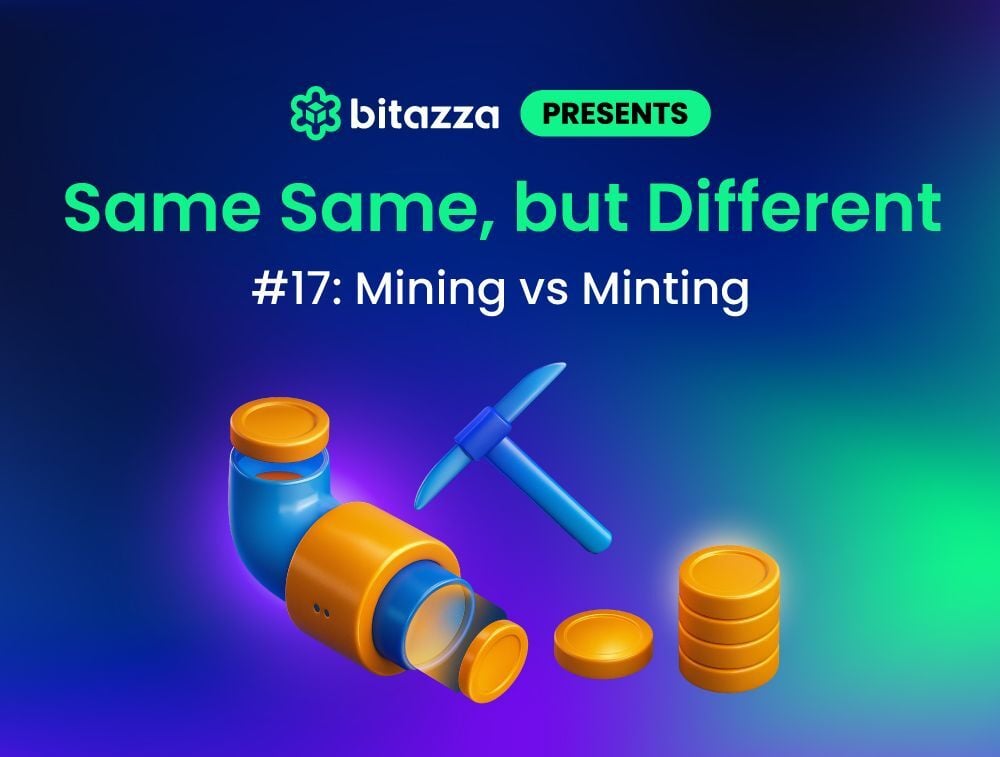Share this
Same Same, but Different #17- Mining vs Minting
Same Same, but Different #17— Mining vs Minting

In the blockchain world, new tokens don’t just appear. They’re either mined or minted into existence, whether crypto or NFTs. Both mining and minting terms refer to the creation of digital assets, but the how, why, and where are completely different.
One requires computational power. The other runs on code and logic. Let’s break it down.
Same Same: Both Create New Tokens
Mining and minting are both legitimate methods to introduce new tokens into a blockchain ecosystem.
They both:
- Result in token supply expansion
- Follow rules set by the blockchain protocol
- Reward participants who follow the network’s conditions
But how these tokens are created also depends entirely on the system they belong to.
Different: Proof of Work (PoW) vs. Code-Based Creation
Mining is specific to Proof of Work (PoW) blockchains like Bitcoin and Litecoin.
How it works:
- Miners compete to solve a cryptographic puzzle
- The first to solve it validates the block and earns the reward
- This process requires specialized equipment (ASICs or GPUs) and large amounts of electricity
Key facts (as of mid-2025):
- Bitcoin’s block reward is currently 3.125 BTC until the next halving in April 2028
- Mining provides both security and decentralization
- Used by PoW blockchains: Bitcoin, Litecoin, etc.
Pros: High security and decentralization
Cons: High energy usage, expensive setup
Minting is the process of creating new tokens through smart contracts or protocol logic. It’s the standard method used on Proof of Stake (PoS) chains, NFT platforms, and DeFi apps.
How it works:
- Tokens are issued when users meet predefined criteria (e.g., staking, claiming rewards, creating NFTs)
- Minting only requires blockchain interaction with no hardware
- Often involves a gas fee, but minimal energy consumption
Used by:
- PoS blockchains like Ethereum (post-Merge), Solana, Avalanche
- Web3 platforms like Freedom World
- NFT platforms like OpenSea, Magic Eden, Zora
Pros: Low energy usage and accessible to anyone with a wallet
Cons: Smart contracts must be secure as bad code = bad mint
Quick Comparison Table
|
Feature |
Mining (PoW) |
Minting (PoS, NFTs, DeFi) |
|
Mechanism |
Solving cryptographic puzzles |
Triggered by code or protocol logic |
|
Energy Consumption |
High |
Low |
|
Hardware Requirement |
ASICs, GPUs |
None (just a wallet and internet) |
|
Common Use Case |
Bitcoin network security |
NFT creation, staking rewards |
|
User Barrier to Entry |
High (technical + hardware costs) |
Low (anyone can mint NFTs or stake) |
|
Examples |
Bitcoin, Litecoin |
Ethereum (PoS), Solana, NFT projects |
Why It Matters
Both mining and minting play a role in how blockchain ecosystems grow.
Use Mining if you're:
- Participating in PoW security
- Running physical infrastructure
- Earning through hashrate competition
Use Minting if you're:
- Staking or farming in DeFi
- Creating NFTs
- Engaging in a PoS-based ecosystem
As of 2025, most new chains and apps avoid PoW in favor of PoS and mint-based logic for scalability, sustainability, and lower entry barriers. So just remember this key difference.
- Mining = compete and earn.
- Minting = create and issue.
Same same, but definitely different.
Start Exploring
Join the Future of Token Creation with BitazzaWhether you’re earning rewards through staking or trading newly minted tokens, Bitazza has the tools to support your journey. Read more on our blog
Share this
- Crypto 101 (75)
- Trading (68)
- Crypto Weekly (47)
- Educational (43)
- Bitazza 101 (41)
- Featured (19)
- Missions (8)
- Market (6)
- Bitazza Insight (5)
- Research (5)
- Derivatives (4)
- TradingView (4)
- Education (3)
- Futures Trading (3)
- Freedom Shards (1)
- Freedom Token (FDM) (1)
- Intermediate (1)
- Product and features (1)
- Tether (1)
- Tether (USDt) (1)
- crypto exchange (1)
- December 2025 (12)
- November 2025 (6)
- October 2025 (10)
- September 2025 (8)
- August 2025 (17)
- July 2025 (29)
- June 2025 (13)
- May 2025 (14)
- April 2025 (12)
- March 2025 (8)
- February 2025 (8)
- January 2025 (8)
- December 2024 (7)
- November 2024 (5)
- October 2024 (14)
- September 2024 (9)
- August 2024 (14)
- July 2024 (3)
- June 2024 (48)
No Comments Yet
Let us know what you think